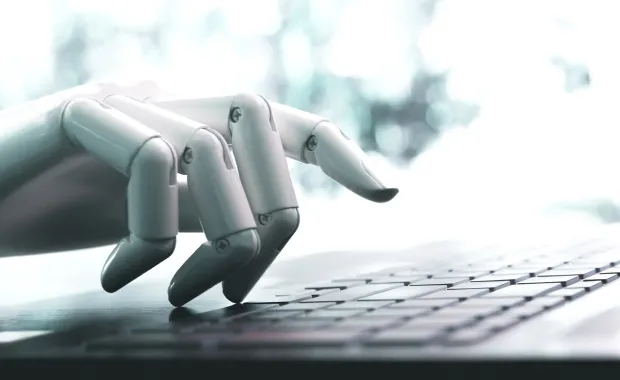I want to tell you a story about an AI chatbot who took over an organization. Now when I say took over, I don’t mean like what you see in sci-fi movies with humans running for their lives – but from a transformative end user experience perspective.
First, let me take you back to where it all started, with a call center director at an up and coming healthcare provider – we’ll call him Jim – who has just started his day on a busy Monday morning. There is a large queue of callers that have been waiting for over 20 minutes to speak to a call center representative. Jim thinks to himself, why can't he find employees that are reliable and engaged? Once again, five people have called out sick, making it very hard to provide a top-tier customer experience. Jim has the typical business constraints around time, money, and people, and he can't afford to sit around and wait for a solution. If this keeps up, Jim will be looking for a new job since his customer satisfaction numbers are dropping drastically. Jim wondered how he could tackle the unpredictability of staff turnover in his call center in order to provide a more streamlined experience to his callers.
Jim has read about AI, chatbots, and digital workers from his partner email subscriptions and decided to do some research online about chatbots and their ability to perform in place of human staff members. Based on what he’s read, he believes he has found the solution to his concerns. His new problem though is that he really doesn’t know how to begin implementing this AI technology.
Can any of you out there think of a time you interacted with AI or a chatbot? Recent polls and studies show that most people have done so without even knowing it. The market for hyper-automation technologies will reach $596 billion in 2022, an increase of nearly 24% from 481.6 billion in 2020. Analysts have gone even further to explain that we can expect significant growth in areas that enable organizations to automate processes rapidly. Hyper-automation technologies include robotic process automation (RPA), low-code application platforms (LCAP), AI, and virtual assistants.
Thinking bigger than chatbots
When Jim first approached a trusted automation expert and explained the concerns with his call center, it became clear that the solution to his problem was more than just the implementation of a chatbot to replace the common worker. Jim needed to be encouraged to think bigger, and strive for that 10 X idea. What was the real goal behind introducing a chatbot?
This line of discussion brought the realization to life that it was not so much about the chatbot itself to replace workers, but the idea of using machine learning and AI to incorporate algorithms that facilitate and solve repeatable tasks. One important take away was that the implementation of AI like Amelia would actually free up his team members to focus on more challenging tasks that bring business value. Furthermore, the new tasks would create more interesting and challenging work and drive up employee morale.
Jim’s starting point for automation – chatbots for the call center – isn’t that unusual. We often find clients beginning their automation journey with a point solution that evolves into a larger use case as the organization starts to see tangible benefits. One might, for instance, determine that machine learning and AI could be leveraged to drive a digital experience transformation for a call center, which would ultimately extend and flow into other areas of the organization. Chatbots on their own, as they are today at least, cannot operate without human configuration and continual data feeding. Sure, machine learning can help your AI get smarter over time, but it is the information, and more specifically, the quality of that information that we feed into the AI that dictates the level that it can develop, learn and automate.
Trusted partners in automation
CGI has been using hyper-automation technologies for many years to drive operational efficiencies. We recently reviewed our US Global Technology Operations and determined that, through our Amelia AI digital workers, we have implemented over 12,000 automation workflows that monitor over 30 different technologies for our customers. Through AI, our intent recognition and resolution rates have reached 85%, and AI is able to resolve 67% of incidents without any human interaction. Because of these great achievements, our clients are seeing a 30% reduction in outages and averaging 30% savings in operational costs the equivalent of 33 FTEs of effort per month.
CGI helps organizations to take a step back, look at the big picture and determine the plan to move forward into the future. It’s not science fiction, it’s a reality within reach. We start by assessing and optimizing the completeness and thoroughness of an organization’s data sets. This allows an organization to understand where they can start to leverage AI and machine learning in their digital transformation journeys. The roadmap allows an organization to understand the where, when, and how intelligent hyper-automation technologies fit within the business plan. Ultimately, these technologies will help reduce operational costs and improve operational efficiencies, but most importantly, they need to contribute to your organization’s digital journey and introduce an enhanced customer experience – a top business priority – for your end users.





